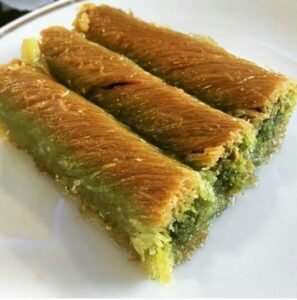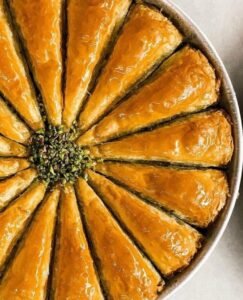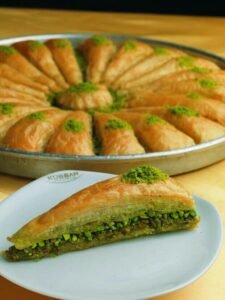Introduction to Turkish Baklava and Its Variations
Turkish baklava rolls with pistachios are a gastronomic wonder. They produce a delight that melts in your lingo by combining rich pistachios, sweet saccharinity, and delicate layers of phyllo dough. This dish is further than just a confection; it represents Turkish hospitality, moxie, and tradition. Centuries of culinary mastery are apparent in every taste. The history, factors, and styles of making this well- liked treat will all be covered in this composition. Everything you need to know about Turkish pistachio baklava rolls is then, anyhow of your preference for goodies or your interest in food.

The History of Baklava in Turkey
Baklava is a delicacy with a long history that’s intricately woven into Turkish culture. It’s known for its thick, short layers and sweet saccharinity. Although its precise origins are over for contestation, baklava is considered a culinary gem of the Ottoman Empire, developed in Turkey and now enjoyed each over the world.
Roots in the Ottoman Era
Baklava’s origins in Turkey can be traced back to the Ottoman Empire’s kitchens, videlicet the Topkapı Palace in Istanbul. Using the stylish constituents available, Ottoman cookers created baklava as a cate for lords and queens. It was a valued product at carnivals and special events because of the meticulous medication procedure, which represented fineness and complication.
Pistachio: The King of Nuts
Although there are other types of baklava, the pistachio variety is particularly valued in Turkish cuisine. The stylish pistachio baklava is produced in the southeast of Gaziantep, which is appertained to as the pistachio capital of Turkey. Baklava is elevated to an art form by the region’s perfect temperature and rich soil, which produce pistachios of unequaled flavor and quality.
A Symbol of Hospitality and Celebration
Baklava is further than just a cate in Turkish culture; it’s a sign of benevolence and kindness. It’s constantly presented to guests as a commemorative of respect or participated during religious leaves like Eid and Ramadan. Because of their rich flavor and sophisticated donation, pistachio baklava rolls in particular have grown in fashionability.

Modern-Day Popularity
Pistachio baklava rolls stand out as a distinctive and popular variety of Turkish baklava, which is presently a worldwide mode. In order to present baklava to new cult, cookers continue to admire ancient fashions while instituting with creative approaches.
Key Ingredients of Turkish Pistachio Baklava Roll
The quality of the constituents and their simplicity are what make Turkish pistachio baklava rolls so magical. Every element is essential to achieving the ideal balance of flavors and textures.
Phyllo Dough (Yufka)
Baklava’s base is phyllo dough, which is a delicate mix of flour, water, and a gusto of swab. The distinctive short layers that characterize this delicacy are created by rolling it into paper-thin wastes. Baklava is better when the phyllo is thinner. The dough is hand- rolled in traditional Turkish fashions to attain unequaled lightness and delicacy.
Pistachios
The main element in Turkish pistachio baklava rolls is pistachios. Turkish pistachios are valued for their caloric flavor, rich aroma, and pictorial green color, especially those from Gaziantep. The stuffing is composed of finely crushed or roughly diced pistachios, which are also used as a trim to enhance the dish’s appearance and taste.

Butter (Tereyağı)
Baklava requires pure, clarified adulation to produce its golden, brickle layers. Melted adulation is spread over each subcaste of phyllo dough to guarantee indeed incinerating and a deep, nutty taste. The cate ‘s overall flavor and texture are directly impacted by the adulation’s quality.
Sugar Syrup (Şerbet)
Baklava’s distinctive agreeableness comes from the saccharinity, which also holds the factors together. The saccharinity, which is made with sugar, water, and a small quantum of bomb juice, is delicately poured over the warm cooked rolls. In addition to precluding crystallization, the bomb juice balances the agreeableness with a light tang.
The Importance of Quality Ingredients
Baklava is a simple dish, but the quality of the factors matters. Premium adulation, lately carried pistachios, and adroitly set phyllo dough are the main constituents of authentic Turkish pistachio baklava rolls. The flavor and texture of the dish might be lowered by using inferior factors, emphasizing the need of paying close attention to every step of the process.
The Art of Making Turkish Pistachio Baklava Rolls
The fashion of making Turkish pistachio baklava rolls requires tolerance, gift, and close attention to detail. Every stage, from making the dough to putting it together and incinerating it, adds to the cate ‘s distinctive layers of agreeableness, nuttiness, and crispiness.

Preparing the Phyllo Dough
The phyllo dough is the foundation of any excellent baklava roll. Dough is manually rolled into paper-thin wastes for traditional Turkish baklava. To get the delicate texture demanded to produce short layers, this step needs to be done precisely. Homemade Dough Making your own dough is an art, indeed though numerous people choose to use store- bought phyllo. Using a long, thin rolling leg known as an oklava, the dough is rolled out after being sculptured until it’s smooth and allowed to rest. Store- Bought Dough You can use premade phyllo dough for convenience. For the stylish results, make sure it’s fresh, thin, and malleable.
Preparing the Filling
The centerpiece of this dish is the pistachio stuffing. To balance texture and flavor, Turkish baklava rolls generally contain either coarsely diced or finely ground pistachios. Grinding Grind the pistachios just enough to release their canvases without immolating texture. Seasoning The pistachios’ essential agreeableness and nuttiness are sufficient; no fresh seasoning is needed.

Layering the Phyllo Dough
Adulation the Layers To guarantee that the phyllo dough bakes unevenly and crisps up wonderfully, melted adulation is spread on each subcaste. Add the Filling Spread a substantial quantum of ground pistachios over the dough after layering multiple wastes.
Conclusion:A Culinary Masterpiece Worth Savoring
Further than just a treat, Turkish pistachio baklava rolls are a festivity of flavor, workmanship, and tradition. These golden rolls, which began in Ottoman kitchens and are now a worldwide treat, represent the culinary moxie of Turkey. It’s a memorable experience since each bite gives the ideal mix of rich pistachios, short layers, and sweet saccharinity. Enjoying pistachio baklava rolls is a trip into the heart of Turkish heritage, whether you’re motivated to attempt creating them at home or looking for a real bakery. Enjoying this classic dish means further than just indulging in a cate ; it’s a part of a culinary tradition that has thrilled generations.
